HBM - Hottinger Baldwin Messtechnik GmbH (Japan) - Renewable energy sources are key to overcoming the challenges of the clean energy revolution. aerodyn engineering develops new systems that allow better utilization of the force of airflows to generate power. Testing these plants under harsh conditions requires dependable testing and measuring equipment. The wind power experts rely on HBM sensors for the testing of a new offshore turbine off the Japanese coast. The S9M force transducer from the global technology and market leader in test and measurement provides aerodyn engineering with precisely measured data, even with measurements below the sea surface.
The global demand for energy is growing rapidly. Every year, 16,330 billion kilowatt-hours of electrical energy is consumed worldwide, and the number only keeps rising. Renewable energy sources are especially becoming increasingly important to power generation.
The reason behind this is that, to reduce CO2 emissions and limit climate change, technologies that generate power more efficiently and that are more environmentally friendly than, for instance, traditional gas and coal power stations are required. aerodyn engineering develops innovative wind turbines that allow better utilization of wind power. Before deploying these systems, the technology company located in Büdelsdorf, Schleswig-Holstein, Germany performs tests to investigate how their constructions prove themselves under extreme environmental conditions. These series of complex tests require robust testing and measuring equipment that provides reliable data, even underwater. Experts at aerodyn engineering, therefore, use high-grade sensor technology such as HBM’s high-precision S9M force sensor to test a new offshore wind turbine.
Trial run for the floating wind turbine:
The average seawater temperature off the coast of the Japanese island of Kurahashi is 10 °C. Here, in Hiroshima Bay, aerodyn engineering is currently testing a floating wind turbine that independently aligns itself in the direction of the wind. Three thin floats keep the structure that has a total weight of three metric tons afloat on water. Two rotor blades that span over 16 meters have been installed on the eight-meter-high tower.
"The turbine delivers an output of five kilowatts with good wind conditions. However, this is just a model in scale 1:10. The full-size turbine will weigh about 3,000 metric tons and generate up to six megawatts power later," explains Martin Bode, Senior Chief Engineer at aerodyn engineering. Six steel cables fixed to six anchoring points at the bottom of the sea are used to stabilize the wind turbine in its position. The swivel joint, where the anchoring cables meet, allows the entire turbine to freely align itself according to the direction of the wind. It is important for the tests to determine the stress to which the turbine’s anchoring system is subjected. “Whether they are exposed to heavy storms or high waves, the wind turbines anchors need to withstand extremely rough conditions in the long term later. It is therefore essential to our measurements to use extremely robust force transducers that can be used underwater for several months, "says Martin Bode. The sensors also need to provide very precise and detailed results to enable dependable data for the full-size turbine to be derived from the model test.
“We need reliable testing and measuring equipment for the complex testing of our new offshore wind turbine. The S9M force transducers provide reliable and very precise data about the tensile loading of our anchoring system, even in extremely harsh conditions at sea,“ says Martin Bode, Senior Chief Engineer at aerodyn engineering.
S9M force sensor: Extremely high precision also in the sensor’s lower measurement range:
The experts from HBM, the global technology and market leader in test and measurement, have advised aerodyn engineering and presented them with various sensors.
“Our hermetically encapsulated S9M force sensor is the optimal solution for aerodyn engineering’s measurements below the sea surface that take several months. Our products are thoroughly tested. This ensures that every sensor fully meets our and our customers’ quality requirements,“ says Christoph Miks, HBM Sales Engineer.
The S9M force sensor optimally meets the wind power experts’ requirements. The S-shaped force transducer is available with seven different capacities, ranging from 0.5 kN to 50 kN. It measures tensile and compressive forces very precisely and can be used for a wide range of static and dynamic measurement applications; for instance, in test benches, lever-arm torque measurements, and production and monitoring tasks. "Due to its minimized temperature dependence and the very small effect of parasitic forces, the S9M allows for extremely high precision in the sensor’s lower measurement range, also in extremely harsh environments, regardless of whether force is measured in industrial applications or below the sea surface,” says Christoph Miks, HBM Sales Engineer.
The S9M offers high accuracy (HBM accuracy class: 0.02); thus, it provides a precision that is unique for a sensor with this design and is also extremely robust. The force sensor is hermetically sealed and is rated with an IP68 degree of protection, i.e., it is suitable for immersion underwater. “The welded and sealed strain-gauge installation optimally protects the sensitive strain gauges against the ingress of water, also during the long-term measurements performed by aerodyn engineering. Our products are thoroughly tested to ensure that every sensor fully meets our and our customers’ quality requirements," states Christoph Miks.
Suitable for huge waves and extremely robust due to its steel measuring body:
“Our turbines will be exposed to very high wind speeds of up to 25 meters per second, which is a really heavy storm,” explains Martin Bode, “the anchoring cables also need to withstand high waves of up to 17 meters.”
Strong waves are likely to occur off the coast of Kurahashi, too, which can subject the anchoring cables to very high tensile loading temporarily. The S9M is extremely accurate, even with high capacities. Therefore, a sensor with a higher capacity can be used in applications where high overloads are likely to occur. The sensor’s excellent performance guarantees highly precise measurement results.
“Our innovative wind power systems promote the clean energy revolution. To achieve this, we need partners that join us in breaking new ground. The HBM experts advise us to enable us to get optimal results from our tests. They have always assisted us quickly in our projects worldwide, due to their global presence,“ says Martin Bode, Senior Chief Engineer at aerodyn engineering.
Besides the S9M force sensor, aerodyn engineering uses additional accessories such as the matching knuckle eyes that are optimally tailored to the sensor’s capacity. The wind power experts additionally use the U9C miniature load cell to measure the tensile loading of the rotor tower’s three guy ropes. Due to its high dynamics and robust stainless-steel measuring body, it precisely acquires load changes in the guy ropes over a long period of time. "We offer a wider range of sensors and measurement electronics for every requirement,” says Christoph Miks. “We provide our customers with technology comprising the complete measurement chain from a single source, ranging from the sensors to the measurement electronics and matching installation accessories.”
aerodyn engineering has relied on HBM’s extensive expertise in sensors and testing and measuring technology for several years. "We need a partner that joins us in breaking new ground and promoting our innovative wind energy concepts,” says Martin Bode, “The HBM experts advise us and provide us with high-grade, dependable technologies that make our prototype test runs more efficient and reliable. We benefit from HBM’s global presence in our tests worldwide, for instance, when spontaneous measurement missions require rapid deployment.”
Problem:
aerodyn engineering is currently testing the model of a new floating wind turbine off the coast of the Japanese island of Kurahashi that can independently align itself according to the direction of the wind because of a swivel joint. An important aim of this series of tests is to determine the load on the six anchoring cables that are fixed at the bottom of the sea to keep the wind turbine in its position. The measurements that take several months require dependable testing and measuring equipment with the following features:
- Highly precise
- Water-proof for long-term measurements below the sea surface
- Resistant against high overloads and corrosion in the aggressive seawater
Solution:
For its series of tests, aerodyn engineering uses the S-shaped high-precision S9M force sensor and various installation accessories. Additionally, HBM’s U9C miniature load cell is used for further measurements of the rotor tower’s guy ropes.
- The S9M offers an accuracy class of 0.02 and, thus, a precision that is unique for its design. It provides reliable data in extremely unfavorable conditions due to its minimized temperature dependence and resistance against the effects of parasitic forces.
- The S9M force sensor’s hermetical sealing makes it ideal for long-term use underwater. Moreover, its robust stainless-steel measuring body is corrosion-resistant in the aggressive seawater and reliably withstands overloads of up to three times its capacity.
- The installation accessories, such as the knuckle eyes, are optimally matched to the sensors to ensure optimal measurement results.
Result:
- The S9M force sensor provides precisely measured data due to its high accuracy and enables dependable data for the full-size turbine to be derived from the model test.
- The welded and sealed strain-gauge installation optimally protects the sensitive strain gauges against the ingress of water during a series of tests that are conducted over several months.
- HBM's S9M and U9C are two robust sensors that can acquire the dynamic loading of both the anchoring cables and the rotor tower’s guy rods precisely and in detail.
About Aerodyn Engineering:
develops and tests innovative wind power plants and components, such as turbines and rotor blades, for onshore and offshore use. Wind turbines developed by aerodyn can be found on five continents. They help make power generation more eco-friendly and allow for better utilization of renewable energy sources such as wind power. The various system concepts available from the company located in Büdelsdorf, Schleswig-Holstein, Germany provide up to 6,500 kW of rated power.












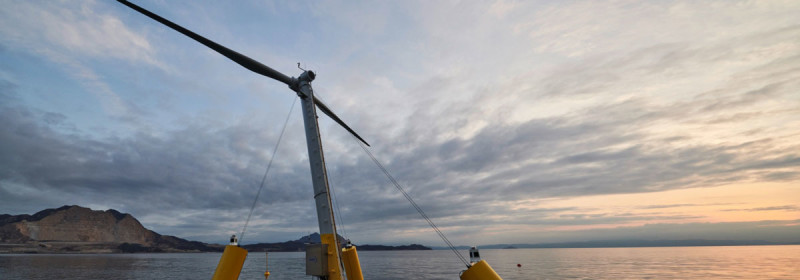
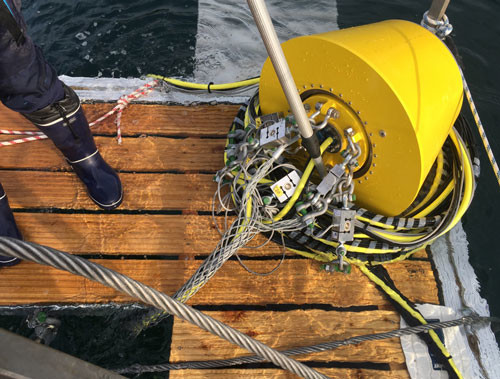
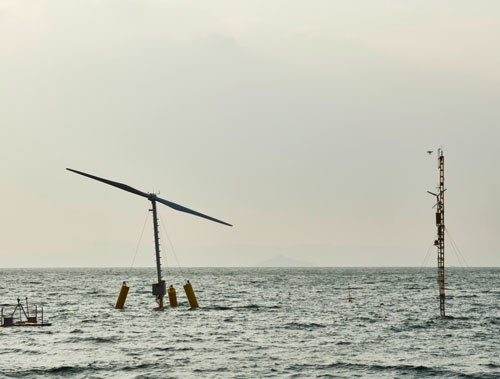
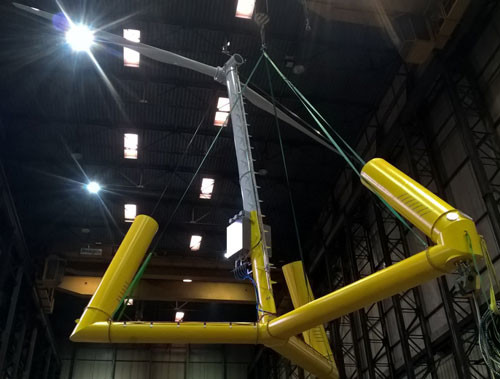


















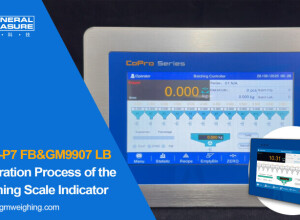












Interested? Submit your enquiry using the form below:
Only available for registered users. Sign In to your account or register here.